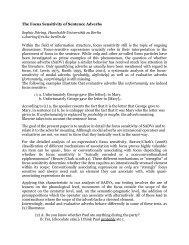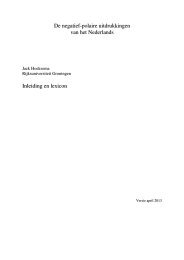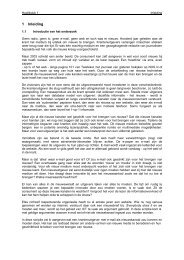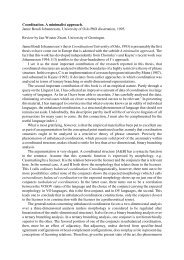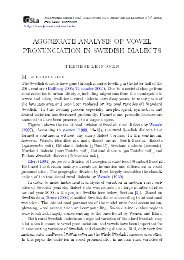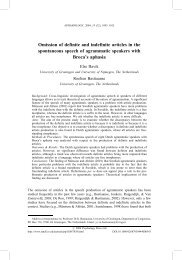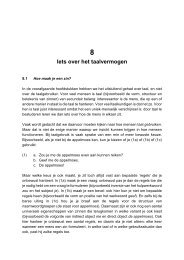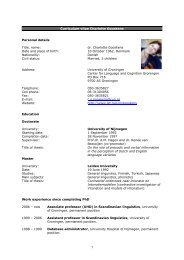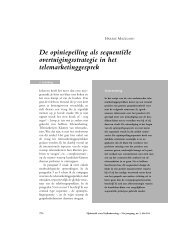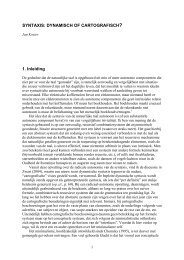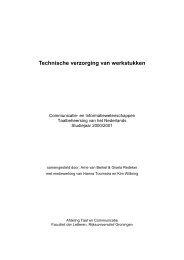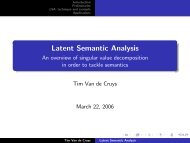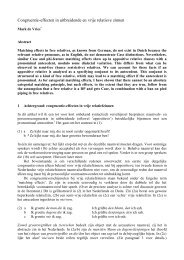The origin of Afrikaans pronunciation: a comparison to west ...
The origin of Afrikaans pronunciation: a comparison to west ...
The origin of Afrikaans pronunciation: a comparison to west ...
Create successful ePaper yourself
Turn your PDF publications into a flip-book with our unique Google optimized e-Paper software.
<strong>The</strong> <strong>origin</strong> <strong>of</strong> <strong>Afrikaans</strong> <strong>pronunciation</strong>:<br />
a <strong>comparison</strong> <strong>to</strong> <strong>west</strong> Germanic languages and Dutch dialects<br />
Wilbert Heeringa, Febe de Wet<br />
Meertens Institute, Variationist Linguistics<br />
wilbert.heeringa@meertens.knaw.nl<br />
Stellenbosch University, Centre for Language and Speech Technology<br />
fdw@sun.ac.za<br />
Abstract<br />
This paper aims <strong>to</strong> find the <strong>origin</strong> <strong>of</strong> the <strong>Afrikaans</strong> <strong>pronunciation</strong><br />
with the use <strong>of</strong> dialec<strong>to</strong>metry. First, <strong>Afrikaans</strong> was compared<br />
<strong>to</strong> Standard Dutch, Standard Frisian and Standard German.<br />
Pronunciation distances were measured by means <strong>of</strong> Levenshtein<br />
distances. <strong>Afrikaans</strong> was found <strong>to</strong> be closest <strong>to</strong> Standard<br />
Dutch. Second, the <strong>Afrikaans</strong> <strong>pronunciation</strong> was compared<br />
<strong>to</strong> 361 Dutch dialect varieties in the Netherlands and<br />
North-Belgium. Material from the Reeks Nederlandse Dialectatlassen<br />
was used. <strong>Afrikaans</strong> was found <strong>to</strong> be closest <strong>to</strong> the<br />
South Holland variety <strong>of</strong> Zoetermeer, which largely agrees with<br />
Kloeke (1950, Herkomst en Groei van het <strong>Afrikaans</strong>).<br />
1. Introduction<br />
<strong>Afrikaans</strong> is a daughter language <strong>of</strong> Dutch and is mainly spoken<br />
in South Africa and Namibia. Reenen & Coetzee [1] briefly describe<br />
the <strong>origin</strong> <strong>of</strong> <strong>Afrikaans</strong>. Nearly 350 years ago, in 1652,<br />
Jan van Riebeeck founded a refreshment station at the Cape <strong>of</strong><br />
Good Hope on the way <strong>to</strong> the Indies and introduced a Dutch<br />
variety. He and the group around him came from the southern<br />
part <strong>of</strong> the Dutch province <strong>of</strong> South-Holland. Van Reenen &<br />
Coetzee refer <strong>to</strong> Kloeke [2] who claims that Jan van Riebeeck’s<br />
group is the most important source <strong>of</strong> <strong>to</strong>day’s <strong>Afrikaans</strong> language.<br />
Kloeke writes extensively about the <strong>origin</strong> <strong>of</strong> <strong>Afrikaans</strong><br />
in his Herkomst en Groei van het <strong>Afrikaans</strong> ‘Origin and growth<br />
<strong>of</strong> <strong>Afrikaans</strong>’. Van Reenen & Coetzee also refer <strong>to</strong> Scholtz [3,<br />
p. 254] who does not agree with Kloeke but wonders whether<br />
<strong>Afrikaans</strong> is derived from a common Hollandish language, the<br />
Hollandish norm <strong>of</strong> the second half <strong>of</strong> the 17th century. However,<br />
Van Reenen & Coetzee doubt whether a common Hollandish<br />
language already existed in that period.<br />
<strong>The</strong> South African constitution recognizes 11 <strong>of</strong>ficial languages.<br />
According <strong>to</strong> the 2001 census data, Zulu is the most<br />
widely spoken mother-<strong>to</strong>ngue in South Africa, followed by<br />
Xhosa and <strong>Afrikaans</strong>, with the latter constituting 13.3% <strong>of</strong> the<br />
population. This percentage is lower than the value reported<br />
in the 1996 census, when 14.4% <strong>of</strong> the population indicated<br />
that <strong>Afrikaans</strong> was their first language [4]. This observation can<br />
probably be explained by a decline in population growth as well<br />
as the fact that many <strong>Afrikaans</strong> people emigrated during that period.<br />
Although English is most <strong>of</strong>ten used as the lingua franca<br />
in the country, <strong>Afrikaans</strong> is more frequently used than English<br />
in some provinces <strong>of</strong> South Africa and Namibia.<br />
As explained above, <strong>Afrikaans</strong> is seen his<strong>to</strong>rically as a<br />
daughter <strong>of</strong> Dutch. This paper shows that <strong>Afrikaans</strong> is linguistically<br />
still a daughter <strong>of</strong> Dutch. In order <strong>to</strong> prove this, the<br />
<strong>Afrikaans</strong> <strong>pronunciation</strong> is compared <strong>to</strong> the <strong>pronunciation</strong> <strong>of</strong><br />
the languages in the <strong>west</strong> Germanic language group: Standard<br />
Dutch, Standard Frisian and Standard German. Pronunciation<br />
distances are measured with Levenshtein distance, a string edit<br />
distance measure. Kessler [5] was the first <strong>to</strong> use Levenshtein<br />
distance for measuring linguistic distances. He applied Levenshtein<br />
distance <strong>to</strong> transcriptions <strong>of</strong> Irish Gaelic dialect varieties.<br />
Later Levenshtein distances was applied <strong>to</strong> Dutch dialects by<br />
Nerbonne et al. [6] (more detailed results are given by Heeringa<br />
[7], <strong>to</strong> Norwegian by Gooskens & Heeringa [8] and <strong>to</strong> several<br />
other dialect families.<br />
<strong>The</strong> Levenshtein distance corresponds <strong>to</strong> the distance between<br />
the transcriptions <strong>of</strong> two <strong>pronunciation</strong>s <strong>of</strong> the same concept<br />
corresponding <strong>to</strong> two different varieties. <strong>The</strong> distance is<br />
equal <strong>to</strong> the minimum number <strong>of</strong> insertions, deletions and substitutions<br />
<strong>of</strong> phonetic segments needed <strong>to</strong> transform one transcription<br />
in<strong>to</strong> another. <strong>The</strong> distance between two varieties is<br />
based on several <strong>pronunciation</strong> pairs, in our case 125. <strong>The</strong><br />
corresponding Levenshtein distances are averaged. This paper<br />
aims <strong>to</strong> answer the following question: which <strong>of</strong> these standard<br />
languages is closest <strong>to</strong> <strong>Afrikaans</strong>? <strong>Afrikaans</strong> is also compared<br />
<strong>to</strong> 361 Dutch varieties, found in the Dutch dialect area. This<br />
area comprises the Netherlands and North-Belgium. Material<br />
from the Reeks Nederlandse Dialectatlassen is used. We determine<br />
which dialect variety (or dialect region) is closest <strong>to</strong><br />
<strong>Afrikaans</strong>. Again <strong>pronunciation</strong> differences are measured with<br />
Levenshtein distance. We also distinguish between vowel and<br />
consonant differences.<br />
<strong>The</strong> aim <strong>of</strong> this study is tw<strong>of</strong>old. Firstly, this investigation<br />
sheds light on the linguistic relationship between <strong>Afrikaans</strong> and<br />
the <strong>west</strong> Germanic languages, and between <strong>Afrikaans</strong> and the<br />
Dutch dialects in particular. Secondly, the results <strong>of</strong> this study<br />
will provide useful guidelines for the development <strong>of</strong> speech<br />
technology applications for <strong>Afrikaans</strong>. Human language technology<br />
(HLT) is still a relatively new field in South Africa<br />
and most <strong>of</strong> the South African languages are severely underresourced<br />
in terms <strong>of</strong> the data and s<strong>of</strong>tware required <strong>to</strong> develop<br />
HLT applications such as au<strong>to</strong>matic speech recognition engines,<br />
speech synthesis systems, etc. Development can be accelerated<br />
if existing resources from closely related languages can be used.<br />
We are specifically interested in constructing a large vocabulary<br />
continuous speech recognition system for <strong>Afrikaans</strong>. This requires<br />
large quantities <strong>of</strong> annotated audio data. Given that very<br />
little <strong>Afrikaans</strong> data is currently available, we would like <strong>to</strong> investigate<br />
the possibility <strong>of</strong> using data from closely related languages.
2.1. Dutch dialects<br />
2. Data source<br />
In order <strong>to</strong> study the relationship between <strong>Afrikaans</strong> and Dutch<br />
dialect varieties, it would be preferable <strong>to</strong> use data from about<br />
1652, because that time period would coincide with Jan van<br />
Riebeeck’s influence on the <strong>Afrikaans</strong> language. Of course, we<br />
do not have phonetic transcriptions from that time. <strong>The</strong> oldest<br />
available source containing phonetic transcriptions <strong>of</strong> a dense<br />
sample <strong>of</strong> dialect locations is the Reeks Nederlandse Dialectatlassen<br />
(RND), a series <strong>of</strong> Dutch dialect atlases which were<br />
edited by Blancquaert and Pée [9] in the period 1925–1982.<br />
<strong>The</strong> atlases cover the Dutch dialect area, which comprises the<br />
Netherlands, the northern part <strong>of</strong> Belgium, a smaller north<strong>west</strong>ern<br />
part <strong>of</strong> France and the German county Bentheim.<br />
In the RND, the same 141 sentences are translated and transcribed<br />
in phonetic script for each dialect. Blancquaert mentions<br />
that the questionnaire was conceived as a range <strong>of</strong> sentences<br />
with words that illustrate particular sounds. <strong>The</strong> design<br />
saw <strong>to</strong> it that, for example, possible changes <strong>of</strong> old-Germanic<br />
vowels, diphthongs and consonants are represented in the questionnaire.<br />
Since digitizing the phonetic texts is time-consuming<br />
and the material was intended <strong>to</strong> be processed by the wordbased<br />
Levenshtein distance, a set <strong>of</strong> only 125 words was selected<br />
from the text (Heeringa [10]). <strong>The</strong> words are selected<br />
more or less randomly and may be considered as a random sample.<br />
<strong>The</strong> transcriptions <strong>of</strong> the 125 word <strong>pronunciation</strong>s were<br />
digitized for each dialect. <strong>The</strong> words represent (nearly) all<br />
vowels (monophthongs and diphthongs) and consonants. <strong>The</strong><br />
consonant combination [sx] is also represented, which is pronounced<br />
as [sk] in some dialects and as [S] in some other dialects.<br />
<strong>The</strong> RND contains transcriptions <strong>of</strong> 1956 Dutch varieties.<br />
Since it would be very time-consuming <strong>to</strong> digitize all transcriptions,<br />
a selection <strong>of</strong> 361 dialects has been made (see Heeringa<br />
[10]). When selecting the dialects, the goal was <strong>to</strong> get a net<br />
<strong>of</strong> evenly scattered dialect locations. A denser sampling resulted<br />
in the areas <strong>of</strong> Friesland and Groningen, and in the area<br />
in and around Bentheim. In Friesland the <strong>to</strong>wn Frisian dialect<br />
islands were added <strong>to</strong> the set <strong>of</strong> varieties which belong <strong>to</strong> the<br />
(rural) Frisian dialect continuum. In Groningen, some extra localities<br />
were added because <strong>of</strong> personal interest. In the area in<br />
and around Bentheim extra varieties were added because <strong>of</strong> a<br />
detailed investigation in which the relationship among dialects<br />
at both sides <strong>of</strong> the border was studied. Besides the relationship<br />
<strong>to</strong> Standard Dutch and Standard German was studied (see<br />
Heeringa et al. [10]).<br />
In the RND, the transcriptions are noted in some predecessor<br />
<strong>of</strong> IPA. <strong>The</strong> transcriptions were digitized using a computer<br />
phonetic alphabet which might be considered as a dialect <strong>of</strong> X-<br />
SAMPA. <strong>The</strong> data is freely available at http://www.let.<br />
rug.nl/˜heeringa/dialec<strong>to</strong>logy/atlas/rnd/.<br />
2.2. Languages<br />
In this paper, Dutch dialects are compared <strong>to</strong> <strong>Afrikaans</strong>. <strong>The</strong><br />
125 words, selected from the RND sentences, were therefore<br />
translated in<strong>to</strong> <strong>Afrikaans</strong> and pronounced by an old male and<br />
a young female, both native speakers <strong>of</strong> <strong>Afrikaans</strong>. Old males<br />
are known <strong>to</strong> be conservative speakers while young females are<br />
usually innovative speakers [11]. In our measurements below<br />
we always take the average <strong>of</strong> the two speakers when we compare<br />
Dutch dialects <strong>to</strong> <strong>Afrikaans</strong>. <strong>The</strong> <strong>pronunciation</strong>s <strong>of</strong> the two<br />
speakers were transcribed consistently with the RND transcrip-<br />
tions.<br />
<strong>Afrikaans</strong> is also compared <strong>to</strong> Standard Dutch, Standard<br />
Frisian and Standard German. To ensure consistency with<br />
the existing RND transcriptions, the Standard Dutch transcription<br />
is based on the Tekstboekje <strong>of</strong> Blancquaert [12]. However,<br />
words such as komen, rozen and open are transcribed as<br />
[ko;m@], [ro:z@] and [o;p@]. In the Tekstboekje <strong>of</strong> Blancquaert<br />
these words would end on an [n], as suggested by the spelling.<br />
For more details see Heeringa [10].<br />
<strong>The</strong> RND transcription <strong>of</strong> the Frisian variety <strong>of</strong> Grouw is<br />
used as Standard Frisian. Standard Frisian is known <strong>to</strong> be close<br />
<strong>to</strong> the variety <strong>of</strong> Grouw.<br />
<strong>The</strong> Standard German word transcriptions are based on<br />
Wörterbuch der deutschen Aussprache [13]. However, the transcriptions<br />
were adapted so that they are consistent with the RND<br />
data. In the dictionary the is always noted as [r], never as<br />
[ö]. Because in German both realizations are allowed, for each<br />
<strong>pronunciation</strong> containing one or more ’s two variants are<br />
noted, one in which the [r] is pronounced, and another in which<br />
the [ö] is pronounced. More details are given by Heeringa et<br />
al. [14]. In the measurements below, both realizations will be<br />
taken in<strong>to</strong> account.<br />
3. Measuring <strong>pronunciation</strong> distances<br />
Pronunciation differences are measured with Levenshtein distance.<br />
Pronunciation variation includes variation in sound components<br />
and morphology. <strong>The</strong> items <strong>to</strong> be compared should<br />
have the same meaning and they should be cognates.<br />
3.1. Algorithm<br />
Using the Levenshtein distance, two varieties are compared by<br />
measuring the <strong>pronunciation</strong> <strong>of</strong> words in the first variety against<br />
the <strong>pronunciation</strong> <strong>of</strong> the same words in the second [15]. We determine<br />
how one <strong>pronunciation</strong> might be transformed in<strong>to</strong> the<br />
other by inserting, deleting or substituting sounds. In this way<br />
distances between the transcriptions <strong>of</strong> the <strong>pronunciation</strong>s are<br />
calculated. Weights are assigned <strong>to</strong> these three operations. In<br />
the simplest form <strong>of</strong> the algorithm, all operations have the same<br />
cost, e.g., 1. Assume the Standard Dutch word hart ‘heart’<br />
is pronounced as [hArt] in <strong>Afrikaans</strong> and as [ært@] in the East<br />
Flemish dialect <strong>of</strong> Nazareth (Belgium). Changing one <strong>pronunciation</strong><br />
in<strong>to</strong> the other can be done as follows:<br />
hArt delete h 1<br />
Art replace A by æ 1<br />
ært insert @ 1<br />
ært@<br />
3<br />
In fact many string operations map [hArt] <strong>to</strong> [ært@]. <strong>The</strong><br />
power <strong>of</strong> the Levenshtein algorithm is that it always finds the<br />
least costly mapping. To deal with syllabification in words,<br />
the Levenshtein algorithm is adapted so that only a vowel may<br />
match with a vowel, a consonant with a consonant, the [j] or<br />
[w] with a vowel (and vice versa), the [i] or [u] with a consonant<br />
(and vice versa), and a central vowel (in our research<br />
only the schwa) with a sonorant (and vice versa). In this way<br />
unlikely matches (e.g. a [p] with an [a]) are prevented. <strong>The</strong><br />
longest alignment has the greatest number <strong>of</strong> matches. In our<br />
example we thus have the following alignment:<br />
h A r t<br />
æ r t @<br />
1 1 1
3.2. Operations weights<br />
<strong>The</strong> simplest versions <strong>of</strong> this method are based on a notion <strong>of</strong><br />
phonetic distance in which phonetic overlap is binary: nonidentical<br />
phones contribute <strong>to</strong> phonetic distance, identical ones<br />
do not. Thus the pair [i,6] counts as different <strong>to</strong> the same degree<br />
as [i,I]. <strong>The</strong> version <strong>of</strong> the Levenshtein algorithm used in this paper<br />
is based on the <strong>comparison</strong> <strong>of</strong> spectrograms <strong>of</strong> the sounds.<br />
Since a spectrogram is the visual representation <strong>of</strong> the acoustical<br />
signal, the visual differences between the spectrograms are<br />
reflections <strong>of</strong> the acoustical differences. <strong>The</strong> spectrograms were<br />
made on the basis <strong>of</strong> recordings <strong>of</strong> the sounds <strong>of</strong> the International<br />
Phonetic Alphabet as pronounced by John Wells and Jill<br />
House on the cassette <strong>The</strong> Sounds <strong>of</strong> the International Phonetic<br />
Alphabet from 1995 [16]. <strong>The</strong> different sounds were isolated<br />
from the recordings and mono<strong>to</strong>nized at the mean pitch <strong>of</strong> each<br />
<strong>of</strong> the two speakers with the program PRAAT [17]. Next, for<br />
each sound a spectrogram was made with PRAAT using the socalled<br />
Barkfilter, a perceptually oriented model. On the basis<br />
<strong>of</strong> the Barkfilter representation, segment distances were calculated.<br />
Inserted or deleted segments are compared <strong>to</strong> silence, and<br />
silence is represented as a spectrogram in which all intensities<br />
<strong>of</strong> all frequencies are equal <strong>to</strong> 0. <strong>The</strong> [P] was found closest <strong>to</strong><br />
silence and the [a] was found most distant. This approach is described<br />
extensively in Heeringa [7, pp. 79–119]. In perception,<br />
small differences in <strong>pronunciation</strong> may play a relatively strong<br />
role in <strong>comparison</strong> <strong>to</strong> larger differences. <strong>The</strong>refore logarithmic<br />
segment distances are used. <strong>The</strong> effect <strong>of</strong> using logarithmic distances<br />
is that small distances are weighted relatively more heavily<br />
than large distances. <strong>The</strong> weights will vary between 0 and<br />
1. In a validation study, Heeringa [7, pp. 178–195] found that<br />
among several alternative distances obtained with the Levenshtein<br />
distance measure, using logarithmic Bark filter segment<br />
distances gives results which most closely approximates dialect<br />
distances as perceived by the speakers themselves.<br />
3.3. Vowels and consonants<br />
Besides calculating Levenshtein distances on the basis <strong>of</strong> all<br />
segments (full <strong>pronunciation</strong> distance) we also calculated distances<br />
on the basis <strong>of</strong> only vowel and consonant substitutions.<br />
If distances are calculated solely on the basis <strong>of</strong> vowels, initially<br />
the full phonetic strings are compared <strong>to</strong> each other using<br />
Levenshtein distance. Once the optimal alignment is found,<br />
the distances are based on the alignment slots which represent<br />
vowel substitutions. Consonant substitutions are calculated mutatis<br />
mutandis.<br />
3.4. Processing RND data<br />
<strong>The</strong> RND transcribers use slightly different notations. In order<br />
<strong>to</strong> minimize the effect <strong>of</strong> these differences, we normalized their<br />
data. <strong>The</strong> consistency problems and the way we solved them are<br />
extensively discussed by Heeringa [10][7]. For the same reason<br />
only a part <strong>of</strong> the diacritics found in the RND is used.<br />
As in earlier studies, we processed diacritics for length (extra<br />
short, half long, long), syllabicity (syllabic), voice (voiced,<br />
voiceless) and nasality (nasal) (see Heeringa [7, pp. 109–111]).<br />
In this study the diacritic for rounding (rounded, partly rounded,<br />
unrounded, partly unrounded) is used. <strong>The</strong> distance between<br />
for example [a] and rounded [i] is calculated as the distance between<br />
[a] and [y]. <strong>The</strong> distance between [a] and partly rounded<br />
[i] is equal <strong>to</strong> the average <strong>of</strong> the distance between [a] and [i] and<br />
the distance between [a] and [y]. <strong>The</strong> diacritic for rounding is<br />
important in our analysis since the [W] and [7] are not included<br />
<strong>Afrikaans</strong> Dutch Frisian German<br />
<strong>Afrikaans</strong> 3.2 4.1 5.1<br />
Dutch 3.8 4.2<br />
Frisian 4.8<br />
German<br />
Table 1: Average Levenshtein distances between four standard<br />
languages<br />
in the phonetic transcription system <strong>of</strong> the RND, but transcribed<br />
as unrounded [u] and [o] respectively.<br />
<strong>The</strong> distance between a monophthong and a diphthong is<br />
calculated as the mean <strong>of</strong> the distance between the monophthong<br />
and the first element <strong>of</strong> the diphthong and the distance<br />
between the monophthong and the second element <strong>of</strong> the diphthong.<br />
<strong>The</strong> distance between two diphthongs is calculated as the<br />
mean <strong>of</strong> the distance between the first elements and the distance<br />
between the second elements. Details are given by Heeringa [7,<br />
p. 108].<br />
4. Results<br />
4.1. <strong>Afrikaans</strong> versus Dutch, Frisian and German<br />
<strong>The</strong> Levenshtein distance enables us <strong>to</strong> compare <strong>Afrikaans</strong> <strong>to</strong><br />
other language varieties. Since we selected 125 words, the distance<br />
between a variety and <strong>Afrikaans</strong> is equal <strong>to</strong> the average <strong>of</strong><br />
the distances <strong>of</strong> 125 word pairs. In Table 1 the average Levenshtein<br />
distances between Standard <strong>Afrikaans</strong>, Standard Dutch,<br />
Standard Frisian and Standard German are given. <strong>The</strong> distances<br />
represent the average Levenshtein distances, regardless <strong>of</strong> the<br />
length <strong>of</strong> the alignments the distances are based on. <strong>The</strong> table<br />
shows that <strong>Afrikaans</strong> is most closely related <strong>to</strong> Standard Dutch.<br />
This confirms that <strong>Afrikaans</strong> is a daughter <strong>of</strong> Dutch, as suggested<br />
by Kloeke[2], Van Reenen[1] and others. Furthermore,<br />
we found <strong>Afrikaans</strong> closer <strong>to</strong> Standard Frisian than <strong>to</strong> Standard<br />
German.<br />
4.2. <strong>Afrikaans</strong> versus Dutch dialects<br />
With the use <strong>of</strong> Levenshtein <strong>pronunciation</strong> distances between<br />
<strong>Afrikaans</strong> and 361 Dutch dialect varieties are calculated. <strong>The</strong><br />
results are shown in Figure 1. In the map the varieties are represented<br />
by polygons, geographic dialect islands are represented<br />
by colored dots, and linguistic dialect islands are represented<br />
by diamonds. Lighter polygons, dots or diamonds represent dialects<br />
which are close <strong>to</strong> <strong>Afrikaans</strong> and darker ones represent<br />
the varieties which are more distant. <strong>The</strong> distances in the legend<br />
represent the average Levenshtein distances.<br />
<strong>The</strong> closest varieties are found in the province <strong>of</strong> South-<br />
Holland. Some close varieties are also found in the provinces<br />
<strong>of</strong> North-Holland and Utrecht. <strong>The</strong> dialect variety <strong>of</strong> Zoetermeer<br />
is closest <strong>to</strong> <strong>Afrikaans</strong>. Kloeke[2] claimed that the dialect<br />
<strong>of</strong> the first settlers was the main source <strong>of</strong> <strong>Afrikaans</strong>. <strong>The</strong>se settlers<br />
came from southern part <strong>of</strong> the Dutch province <strong>of</strong> South-<br />
Holland, the area around Rotterdam and Schiedam. Zoetermeer<br />
is slightly north <strong>of</strong> these two locations. <strong>The</strong> Limburg variety <strong>of</strong><br />
Raeren is furthest away.<br />
4.2.1. Vowels<br />
Distances between Dutch dialects and <strong>Afrikaans</strong> based solely<br />
on vowel substitutions are shown in Figure 2. <strong>The</strong> map is
Distance compared <strong>to</strong><br />
Standard <strong>Afrikaans</strong>:<br />
2.8 Zoetermeer<br />
3.2 Standard Dutch<br />
4.1 Standard Frisian<br />
4.8 Raeren<br />
5.1 Standard German<br />
Zoetermeer<br />
Raeren<br />
Figure 1: Distances <strong>of</strong> 361 Dutch dialect varieties compared <strong>to</strong> <strong>Afrikaans</strong>. <strong>The</strong> varieties are represented by polygons, geographic dialect<br />
islands are represented by colored dots, and linguistic dialect islands are represented by diamonds. Lighter polygons, dots or diamonds<br />
represent dialects which are closest <strong>to</strong> <strong>Afrikaans</strong> and darker ones represent the varieties which are most distant. Note that the variety<br />
<strong>of</strong> Zoetermeer is closest <strong>to</strong> <strong>Afrikaans</strong>. <strong>The</strong> IJsselmeer polders (Wieringermeerpolder, Noordoostpolder and Flevopolder) are not under<br />
consideration, so they are left white.
Wateringen<br />
Raeren<br />
Figure 2: Vowel substitution distances <strong>of</strong> 361 Dutch dialect varieties<br />
compared <strong>to</strong> <strong>Afrikaans</strong>. Note that the variety <strong>of</strong> Wateringen<br />
is closest <strong>to</strong> <strong>Afrikaans</strong>, and the variety <strong>of</strong> Raeren is most<br />
distant.<br />
relatively similar <strong>to</strong> the map in Figure 1. Again the South-<br />
Hollandish varieties are close and the southern Limburg varieties<br />
are distant. <strong>The</strong> dialect <strong>of</strong> Wateringen is closest, and the<br />
dialect <strong>of</strong> Raeren is the most distant. <strong>The</strong> Frisian varieties and<br />
the core Low Saxon varieties found in Groningen and Twente<br />
are more distant than in Figure 1. <strong>The</strong> varieties close <strong>to</strong> the<br />
Dutch/French border in the Belgian province <strong>of</strong> Brabant are also<br />
relatively distant.<br />
Our findings agree with Kloeke [2]. In the summary <strong>of</strong> his<br />
book (p. 262–263) he writes:<br />
<strong>The</strong> two chief sources <strong>of</strong> <strong>Afrikaans</strong>, the old dialects<br />
<strong>of</strong> South Holland on the one hand and the<br />
“High” Dutch on the other, are reflected in the vocal<br />
system. In some respect <strong>Afrikaans</strong> is <strong>of</strong> a pronounced<br />
conservative “Holland” dialectal character,<br />
still more conservative than the dialects <strong>of</strong><br />
Holland itself, which are gradually disappearing.<br />
Although the Holland dialects are disappearing, the relationship<br />
with the South-Holland varieties is still found when we<br />
use the RND data.<br />
4.2.2. Consonants<br />
When consonant substitution distances between the Dutch dialects<br />
and <strong>Afrikaans</strong> are calculated, a completely different picture<br />
is obtained, as can be seen in Figure 3. Closest is the<br />
<strong>to</strong>wn Frisian variety <strong>of</strong> Heerenveen. Other Town Frisian varieties<br />
(Harlingen, Staveren, Bolsward, Midsland and Dokkum),<br />
the dialect <strong>of</strong> Oost-Vlieland and the dialect <strong>of</strong> Amsterdam are<br />
also found among the eight closest varieties. <strong>The</strong> map shows<br />
that the Limburg varieties are again distant.<br />
<strong>The</strong> strong relationship with the Town Frisian dialects may<br />
be explained by the fact that both in <strong>Afrikaans</strong> and in Town<br />
Frisian the initial consonant cluster in words like schip ‘ship’<br />
and school ‘school’ is pronounced as [sk], while most other dialects<br />
and Standard Dutch have [sx]. Another shared feature is<br />
Heerenveen<br />
Figure 3: Consonant substitution distances <strong>of</strong> 361 Dutch dialect<br />
varieties compared <strong>to</strong> <strong>Afrikaans</strong>. Note that the variety <strong>of</strong><br />
Heerenveen is closest <strong>to</strong> <strong>Afrikaans</strong>, and the variety <strong>of</strong> Vaals is<br />
most distant.<br />
that the initial consonant in words like vinger ‘finger’ and vijf<br />
‘five’ is a voiceless [f] and the initial consonant in words like<br />
zee ‘sea’ and zes ‘six’ is a voiceless [s]. Most other dialects and<br />
Standard Dutch have initial [v] and [z] respectively, although<br />
there may be a current tendency <strong>to</strong> increasingly unvoice these<br />
fricatives.<br />
<strong>The</strong> relationship <strong>of</strong> <strong>Afrikaans</strong> with Town Frisian may be<br />
an unexpected outcome at first glance. According <strong>to</strong> Kloeke,<br />
Frisian did not have any significant influence on <strong>Afrikaans</strong>.<br />
But he stresses the assumption that once the [sk] <strong>pronunciation</strong><br />
was used in the whole Dutch dialect area. Relics are<br />
presently still found in Frisia, the islands, North-Holland, Overijssel<br />
and Gelderland, but also in Noordwijk and Katwijk in<br />
South-Holland. He also suggests the possibility that, in the 17th<br />
century, there may have been large relic areas in South-Holland<br />
(see p. 225–226).<br />
As <strong>to</strong> the unvoiced fricatives, this phenomenon is partly<br />
found in the RND transcription <strong>of</strong> the South-Hollandish variety<br />
<strong>of</strong> Zoetermeer, but not <strong>to</strong> the same extent as in the Heerenveen<br />
transcription. A similar reasoning as for the [sk] <strong>pronunciation</strong><br />
may also apply here.<br />
5. Conclusions<br />
In this paper, <strong>Afrikaans</strong> was compared <strong>to</strong> the <strong>west</strong> Germanic<br />
standard languages (Dutch, Frisian and German). <strong>Afrikaans</strong><br />
was found <strong>to</strong> be most related <strong>to</strong> Dutch. Van Reenen and<br />
Coetzee[1] rightly refer <strong>to</strong> <strong>Afrikaans</strong> as a daughter <strong>of</strong> Dutch.<br />
When <strong>Afrikaans</strong> is compared <strong>to</strong> 361 Dutch dialects, the South-<br />
Hollandish varieties were found <strong>to</strong> be closest <strong>to</strong> <strong>Afrikaans</strong>.<br />
According <strong>to</strong> Kloeke[2] the southern varieties in the province<br />
<strong>of</strong> South Holland are the main source <strong>of</strong> <strong>Afrikaans</strong>. However,<br />
our closest variety – the dialect <strong>of</strong> Zoetermeer – is found<br />
in the center <strong>of</strong> the province. We did not specifically find<br />
the southern South-Hollandish varieties <strong>to</strong> be closest. It is<br />
likely that the South-Hollandish dialect area has changed since<br />
1652. <strong>The</strong> strong relationship between <strong>Afrikaans</strong> and the South-<br />
Vaals
Hollandish varieties can be explained by their vowels. As<br />
regards the consonants, the Town Frisian varieties are most<br />
closely related <strong>to</strong> <strong>Afrikaans</strong>, probably since they still maintain<br />
features which were lost in the South-Hollandish dialects. <strong>The</strong><br />
southern Limburg varieties are most distant <strong>to</strong> <strong>Afrikaans</strong>, both<br />
when looking at vowel differences and when considering consonant<br />
differences.<br />
<strong>The</strong> results <strong>of</strong> this study indicate that, for the development<br />
<strong>of</strong> au<strong>to</strong>matic speech recognition systems for <strong>Afrikaans</strong>, Standard<br />
Dutch is probably the best language <strong>to</strong> “borrow” acoustic<br />
data from. <strong>The</strong> use <strong>of</strong> acoustic data <strong>of</strong> the South-Hollandish dialects<br />
would be even better, but will probably not be available,<br />
since developers <strong>of</strong> au<strong>to</strong>matic speech systems focus on (accents<br />
<strong>of</strong>) standard languages rather than on dialects.<br />
6. Acknowledgments<br />
We thank Peter Kleiweg for the program which we used for the<br />
visualization <strong>of</strong> the maps in this paper. <strong>The</strong> program is part<br />
<strong>of</strong> the RuG/L 04 package which is freely available at http:<br />
www.let.rug.nl/˜kleiweg/L04. This research is partially<br />
supported by an NRF Focus Area grant for research on<br />
HLT Resources for Closely-Related Languages.<br />
7. References<br />
[1] P. Reenen and A. Coetzee, “<strong>Afrikaans</strong>, a daughter <strong>of</strong><br />
Dutch,” in <strong>The</strong> Origins and Development <strong>of</strong> Emigrant<br />
Languages; Proceedings from the Second Rasmus Colloquium,<br />
Odense University, November 1994, H. F. Nielsen<br />
and Lene Schøsler, Eds. 1996, pp. 71–101, Odense University<br />
Press.<br />
[2] G.C. Kloeke, Herkomst en groei van het <strong>Afrikaans</strong>, Universitaire<br />
Pers, Leiden, 1950.<br />
[3] J. du P. Scholtz, Taalhis<strong>to</strong>riese Opstelle, J.L. van Schaaik,<br />
Pre<strong>to</strong>ria, 1963.<br />
[4] Statistics South Africa, “Census 2001: Key results,” Tech.<br />
Rep., Statistics South Africa, Pre<strong>to</strong>ria, 2001, Available<br />
as: http://www.statssa.gov.za/PublicationsHTML/Report-<br />
03-02-012001/html/Report-03-02-012001.html.<br />
[5] B. Kessler, “Computational dialec<strong>to</strong>logy in Irish Gaelic,”<br />
in Proceedings <strong>of</strong> the 7th Conference <strong>of</strong> the European<br />
Chapter <strong>of</strong> the Association for Computational Linguistics,<br />
Dublin, 1995, pp. 60–67, EACL.<br />
[6] J. Nerbonne, W. Heeringa, E. Van den Hout, P. van der<br />
Kooi, S. Otten, and W. van de Vis, “Phonetic distance<br />
between Dutch dialects,” in CLIN VI, Papers from the<br />
sixth CLIN meeting, G. Durieux, W. Daelemans, and<br />
S. Gillis, Eds., Antwerp, 1996, pp. 185–202, University <strong>of</strong><br />
Antwerp, Center for Dutch Language and Speech (UIA).<br />
[7] W. J. Heeringa, Measuring Dialect Pronunciation Differences<br />
using Levenshtein Distance, Ph.D. thesis, Rijksuniversiteit<br />
Groningen, Groningen, 2004.<br />
[8] Ch. Gooskens and W. Heeringa, “<strong>The</strong> position <strong>of</strong> Frisian<br />
in the Germanic language area,” in On the Boundaries<br />
<strong>of</strong> Phonology and Phonetics, D. Gilbers, M. Schreuder,<br />
and N. Knevel, Eds., pp. 61–87. Center for Linguistics and<br />
Cognition, Groningen, Groningen, 2004.<br />
[9] E. Blancquaert and W. Peé, Eds., Reeks Nederlands(ch)e<br />
Dialectatlassen, De Sikkel, Antwerpen, 1925–1982.<br />
[10] W. Heeringa, “De selectie en digitalisatie van dialecten<br />
en woorden uit de Reeks Nederlandse Dialectatlassen,”<br />
TABU: Bulletin voor taalwetenschap, vol. 31, no. 1/2, pp.<br />
61–103, 2001.<br />
[11] F. Hinskens, P. Auer, and P. Kerswill, “<strong>The</strong> study <strong>of</strong> dialect<br />
convergence and divergence: conceptual and methodological<br />
considerations,” in Dialect change. <strong>The</strong> convergence<br />
and divergence <strong>of</strong> dialects in contemporary societies,<br />
P. Auer, F. Hinskens, and P. Kerswill, Eds., pp. 1–48.<br />
Cambridge University Press, Cambridge, 2005.<br />
[12] E. Blancquaert, Tekstboekje, De Sikkel, Antwerpen, 2nd<br />
edition, 1939, Nederlandse Fonoplaten van Blancquaert<br />
en van der Plaetse, Eerste Reeks.<br />
[13] H. Krech and U. Stötzer, Wörterbuch der deutschen<br />
Aussprache, Max Hueber Verlag, München, 1969.<br />
[14] W. Heeringa, J. Nerbonne, H. Niebaum, R. Nieuweboer,<br />
and P. Kleiweg, “Dutch-German contact in and around<br />
Bentheim,” in Languages in Contact. Studies in Slavic<br />
and General Linguistics, D. Gilbers, J. Nerbonne, and<br />
J. Schaeken, Eds., vol. 28, pp. 145–156. Rodopi, Amsterdam<br />
and Atlanta GA, 2000.<br />
[15] J. B. Kruskal, “An overview <strong>of</strong> sequence <strong>comparison</strong>,” in<br />
Time Warps, String edits, and Macromolecules. <strong>The</strong> <strong>The</strong>ory<br />
and Practice <strong>of</strong> Sequence Comparison, D. Sank<strong>of</strong>f and<br />
J. Kruskal, Eds., pp. 1–44. CSLI, Stanford, 2nd edition,<br />
1999, 1st edition appeared in 1983.<br />
[16] IPA, <strong>The</strong> Sounds <strong>of</strong> the International Phonetic Alphabet,<br />
Department <strong>of</strong> Phonetics and Linguistics, University College<br />
London, London, 1995, Available as audio cassette<br />
or CD.<br />
[17] P. Boersma and D. Weenink, Praat: doing phonetics by<br />
computer, Institute <strong>of</strong> Phonetic Sciences, Amsterdam,<br />
2002, Available at: http://www.praat.org.



